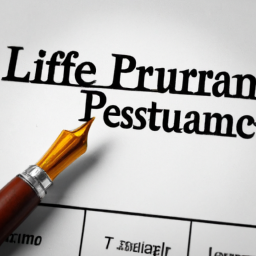Permanent life insurance is a type of life insurance that offers coverage for a lifetime, rather than a set term. Unlike term life insurance, which offers coverage for a specific period, permanent life insurance policies do not expire as long as premiums are paid. Permanent life insurance policies also come with a cash value component that grows over time, providing an additional source of savings.
Despite its benefits, permanent life insurance is more expensive than term life coverage because it lasts a lifetime and typically includes a cash value component in addition to the death benefit. The cost of permanent life insurance varies depending on the type of policy and the age and health of the policyholder.
There are three main types of permanent life insurance policies: whole life insurance, universal life insurance, and variable life insurance. Whole life insurance is the most straightforward type of permanent life insurance, providing a guaranteed death benefit and cash value accumulation. With whole life insurance, you build guaranteed cash value that grows tax-free. You can pull from this cash value to pay for things like college tuition, a down payment on a house, or retirement expenses.
Universal life insurance is another type of permanent life insurance that works similarly to whole life insurance. However, universal life insurance policies offer more flexibility in terms of premiums and death benefits. Policyholders can adjust their premiums and death benefits as their needs change over time.
Variable life insurance is another type of permanent life insurance that offers the potential for higher returns but comes with more risk. With variable life insurance, policyholders can invest their cash value in a range of investment options such as stocks, bonds, and mutual funds.
The primary purpose of permanent life insurance is to provide a death benefit. Using permanent life insurance accumulated value to supplement retirement income is a secondary benefit. However, it’s important to note that any withdrawals or loans from the cash value component of the policy will reduce the death benefit.
Whole life insurance is a type of permanent life insurance policy, which means your policy will cover you for your lifetime, as long as you pay the premiums. Unlike term life insurance policies, which offer coverage for a set period of time, whole life insurance policies offer coverage for life. You can also borrow against the cash value of your policy, providing an additional source of funds when you need them.
Universal life insurance is another type of permanent life insurance that works similarly to straight life insurance. It lasts your lifetime and offers a cash value component that grows over time, providing an additional source of savings. However, universal life insurance policies offer more flexibility in terms of premiums and death benefits. Policyholders can adjust their premiums and death benefits as their needs change over time.
Variable life insurance is a type of permanent life insurance that allows policyholders to invest their cash value in a range of investment options. With variable life insurance, policyholders can choose from a range of investment options such as stocks, bonds, and mutual funds. However, variable life insurance policies come with more risk than other types of permanent life insurance policies.
Whole life insurance covers the insured until they die. There is no term that will expire, and no renewals will need to be completed. This type of policy is ideal for someone who wants to ensure that their beneficiaries receive a death benefit when they pass. It's also great for someone who wants to build cash value that can be borrowed against or used for other purposes.
Premiums for new fixed universal life policies, which are permanent policies with flexible premiums and a cash value that earns a fixed rate of interest, have been decreasing in recent years. However, the cost of permanent life insurance is still higher than term life insurance.
In conclusion, permanent life insurance is a valuable option for those who want lifetime coverage and a cash value component that grows over time. While it may be more expensive than term life insurance, the additional benefits and flexibility make it a good choice for many people. When considering a permanent life insurance policy, it’s important to understand the different types of policies available and the costs and benefits of each.
